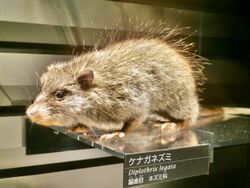Biology:Ryukyu long-tailed giant rat
From HandWiki
Short description: Species of rodent
| Ryukyu long-tailed giant rat | |
|---|---|

| |
| Stuffed specimen. Exhibit in the National Museum of Nature and Science, Tokyo, Japan . | |
| Scientific classification | |
| Domain: | Eukaryota |
| Kingdom: | Animalia |
| Phylum: | Chordata |
| Class: | Mammalia |
| Order: | Rodentia |
| Family: | Muridae |
| Genus: | Diplothrix |
| Species: | D. legata
|
| Binomial name | |
| Diplothrix legata (Thomas, 1906)
| |
| Synonyms[1][2] | |
| |
The Ryukyu long-tailed giant rat or Ryukyu rat (Diplothrix legata) is a species of rodent in the family Muridae. It is the only extant species in the genus Diplothrix. It is found only in the Ryukyu Islands of Japan . Its natural habitat is temperate forests.
Conservation
The species is threatened by habitat loss, predation by feral cats (with studies finding that the rat contributed 23% of feral cat's diet on Amami-Oshima),[3] and introduced nematode and helminth parasites.[4][5]
References
- ↑ 1.0 1.1 Ishii, N. (2016). "Diplothrix legata". IUCN Red List of Threatened Species 2016: e.T6671A22459891. doi:10.2305/IUCN.UK.2016-2.RLTS.T6671A22459891.en. https://www.iucnredlist.org/species/6671/22459891. Retrieved 16 November 2021.
- ↑ Diplothrix legata. pir.uniprot.org
- ↑ Shionosaki, K.; Yamada, F.; Ishikawa, T.; Shibata, S. (2015). "Feral cat diet and predation on endangered endemic mammals on a biodiversity hot spot (Amami–Ohshima Island, Japan)". Wildlife Research 42 (4). doi:10.1071/WR14161.
- ↑ Okano, T.; Haga, A.; Mizuno, E.; Onuma, M.; Nakaya, Y.; Nagamine, T. (2014). "Angiostrongylus cantonensis (Nematoda: Metastrongylidae) in the Ryukyu Islands Tree Rat (Diplothrix legata)". Journal of Wildlife Diseases 50 (2): 322–325. doi:10.7589/2013-03-050.
- ↑ Tokiwa, T.; Yoshimura, H.; Ito, K.; Chou, S.; Yamamoto, M. (2020). "Alien parasitic infections in the endangered Ryukyu long-furred rat (Diplothrix legata) on Amami-Oshima Island, Japan". Parasitology International 76: 102058. doi:10.1016/j.parint.2020.102058.
- Musser, G.G.; Carleton, M.D. (2005). "Superfamily Muroidea". in Wilson, D.E.; Reeder, D.M. Mammal Species of the World: A Taxonomic and Geographic Reference (3rd ed.). Johns Hopkins University Press. pp. 894–1531. ISBN 978-0-8018-8221-0. OCLC 62265494. http://www.departments.bucknell.edu/biology/resources/msw3/browse.asp?id=13001337.
External links
Wikidata ☰ Q302937 entry
 |


